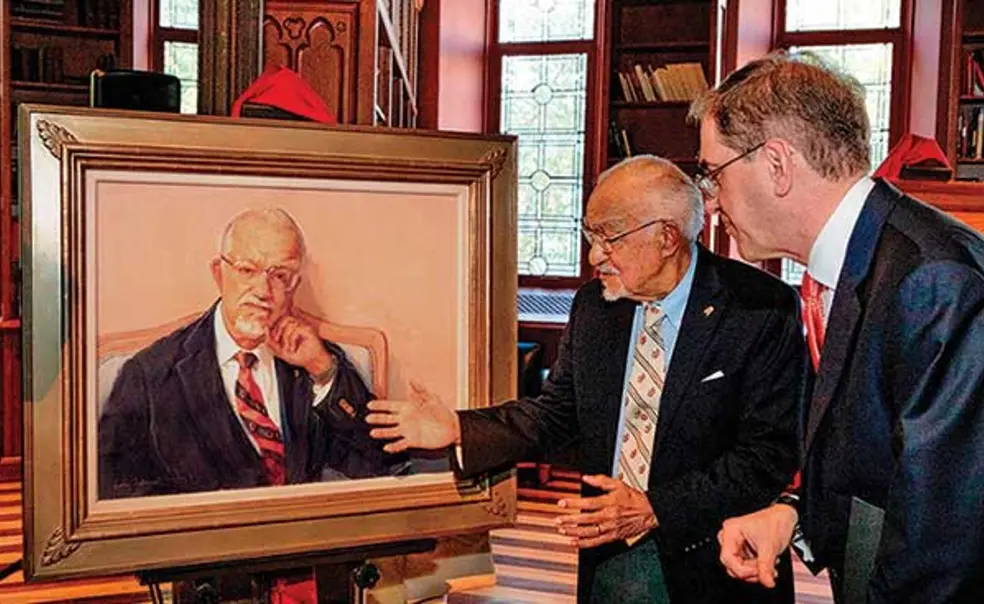In Short
ROBERT J. RIVERS ’53 and President Eisgruber ’83, above, discuss a portrait of Rivers that was unveiled during a Sept. 20 ceremony in Chancellor Green. Rivers, one of the first African American students admitted to Princeton and the first African American member of the Board of Trustees, was one of four people honored with portraits that will be prominently displayed on campus as part of an initiative to highlight exceptional individuals and the diversity of the Princeton community. “My portrait, with my story, is a part of Princeton University’s story, and I enjoy the changes that have taken place during my long Princeton journey,” Rivers said.
The other unveiled portraits are of DENNY CHIN ’75, a judge on the U.S. Court of Appeals for the Second Circuit, a teacher, and an author; ALAN TURING *38, whose doctoral thesis has been called “one of the key documents in the history of mathematics and computer science” and whom Eisgruber described as “an icon in the history of LGBT rights”; and CARL A. FIELDS, Princeton’s first African American administrator, whose efforts Eisgruber said “changed the face of this University and created a lasting legacy.”
Hundreds of students, faculty, and community members took part in the PRINCETON CLIMATE STRIKE Sept. 20, gathering at the Princeton Public Library and marching to the Frist Campus Center with a clear message: The time to act is now. “We are here today to make these [climate] issues heard, to refuse to settle, to disrupt the status quo,” said Pranav Iyer ’22, a speaker at the rally. About 80 Princeton faculty members released a statement in support of the strike.
Author GEORGE WILL *68’s Sept. 17 talk on “Is Constitution Day Unconstitutional?” filled McCosh 50, but there were no signs of the student protest that marked his Baccalaureate address in the Chapel June 2. Then, more than 100 seniors stood with their backs to Will to protest views he expressed in a 2014 column on sexual misconduct. In contrast, Will’s Constitution Day lecture received hearty applause from the audience.
EDMUND WHITE, professor emeritus of creative writing who is best known for his portrayals of gay American life in fiction and nonfiction works, will receive the Medal for Distinguished Contribution to American Letters from the National Book Foundation next month. The annual award recognizes a lifetime of literary achievement.
The Rev. Gabriel Zeis, the University’s Catholic chaplain, resigned Sept. 11 following an ALLEGATION OF SEXUAL ABUSE of a minor in 1975. The Diocese of Trenton said Zeis denied the allegation. A Princeton spokesman said, “Father Zeis was not a University employee, and the University had no role in his resignation.” The University said resources were available for students seeking support.












1 Response
Julia M. Turing
6 Years AgoTuring Was 'Full of Enormous Energy'
The portrait of Alan Turing is very beautifully done, but very disappointed that artist Sokol didn’t capture the powerful beauty and mystery of Alan’s bright blue eyes! Well-written backstory about Alan Turing, but error on Alan’s age of death at 42 -- he was 41. Also, though it's been written by biographers and generally accepted that Alan committed suicide by eating a cyanide-laced apple, the autopsy and police investigation or lack thereof show overwhelming evidence of staged murder to look like suicide. Any experienced forensic scientist can see very clearly of this. Alan was never the kind of person who would give up on anything, especially his life. Creating the "Turing bomb" during WWII under enormous pressure, and finally given credit to singlehandedly saving his country from certain destruction, is evidence of this.
He was full of enormous energy, almost making the Olympic team in the marathon while building the world's most powerful computer of his time simultaneously and inventing the academic field of computer science: thus named "Father of Computer Science"! He should have been awarded the Nobel Prize in mathematics and science; he was deputy director of the first computer lab at Manchester University working on the Farranti Mark I & II, the world's fastest computer at that time, writing the user manual and writing complex coding while simultaneously preparing to publish his latest paper on “Morphogenesis.” Alan was the master of multitasking! He never slowed down until his sudden and tragic death that took everyone who knew him by shock and surprise.